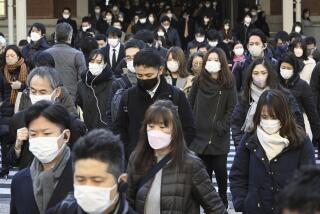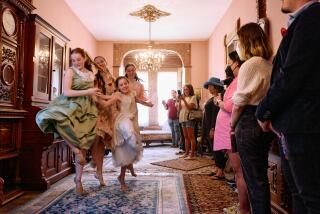Romance Amid the Abstract
- Share via
Merce Cunningham founded his historic career as a choreographer on the search for new movement--particularly new ways of sequencing dance in the body and in space. For an audience with a taste for discovery, the result can be like visiting a magic toyshop or a robotics laboratory, with his handsome and accomplished company continually redefining the norms of motion: dancing off-balance, initiating movement from the unlikeliest of positions, seeing how many things can be combined without losing essential clarity.
At the Orange County Performing Arts Center on Tuesday, for instance, you could watch familiar balletic notions of placement and partnering become fractured and energized in unexpected ways during “Sounddance” from 1974. Adding bobbing heads to balletic shapes or projecting classical steps in the “wrong” direction, Cunningham used just as much ballet, or as little as he needed to create a vocabulary at once familiar yet original.
Wearing gold tops over pale blue-gray leotard bottoms, the 10 dancers hurtled out of a central opening in a long, low wall hung with gold fabric, accompanied by the assaultive whir and whine of a score by David Tudor. Company veteran Robert Swinston was the first (and last) onstage and often represented the exception to the rule--he was kept aloof, for instance, from one engulfing full-cast unison--yet ultimately proved just as involved as anyone else in the forceful overlapping display dances near the end.
In “Rondo” from 22 years later, you could see Cunningham’s experience with computer-assisted choreography adding a whole new layer of possibilities to his “Sounddance” arsenal--particularly in movement created for the upper torso.
Arms with an independent dance identity, shoulders that rotate dramatically when the dancer is already in an extreme stretch or contortion, an outburst of sharp, intricate body squiggles: Welcome to digital Cunningham choreography, a world of whimsical discontinuity in which the accompaniment is likely to be electronics or radically recontextualized sound effects--in this case, John Cage’s “FOUR6” with its endearing tape manipulations of baby cries, brass waa-waas and other found material.
Initially seen in a blue-black void behind a scrim, the 15 “Rondo” dancers eventually emerged into airy, scrimless radiance wearing form-fitting black-and-white street wear by Cunningham and Suzanne Gallo. In some sequences they became a quasi-audience watching an abstraction of well-known forms (a ballroom duet, for instance), but even at their freest, pranciest and most technically wondrous, they looked a mite dry and impersonal. Selfless instruments, as the saying goes.
Happily, Cunningham managed to defy that norm, too--and “Ground Level Overlay” is the latest proof. With its haunting Stuart Dempster trombone score (recorded in an underground water tank near Seattle) and its gleaming Leonardo Drew backdrop of gilded flotsam, this 1995 ensemble piece exudes environmental opulence--with the dancing newly warm, sensual and tinged with mystery.
It begins with a brief premonition of a duet, and, throughout, all the intense group surges leave afterimages of couples facing one another--until just two dancers face each other for the timeless adagio at the heart of the piece. Balancing on one foot, Maydelle Breceda sinks into one backbend after another, lovingly supported each time by Frederic Gafner now calling himself Foofwa d’Imobilite and rocked tenderly back and forth in his arms.
Later he kneels and anchors her as her gaze drifts upward--as if her emotions are opening out from this relationship into an even greater sense of connection. Soon Jared Phillips and Matthew Mohr enter as servants to this feeling of soaring expectation, lifting Gafner and then Breceda, the former floating parallel to the floor, the latter borne aloft like a sacred effigy.
The final group section expands these lifts into a joyous, all-embracing motif, but not before we see Breceda and Gafner again in a passage of revealing intimacy: she leaning against his chest, he touching her foot and looking into her eyes. Romance may be the very last thing you’d expect to find in a Merce Cunningham program, but “Ground Level Overlay” depicts and celebrates it unforgettably.
* The Merce Cunningham Dance Company performs repertory excerpts in a special full-evening event, Saturday at 8 in the Alex Theatre, 216 N. Brand Blvd., Glendale. Tickets: $22.50-$32.50. (800) 233-3123.
More to Read
The biggest entertainment stories
Get our big stories about Hollywood, film, television, music, arts, culture and more right in your inbox as soon as they publish.
You may occasionally receive promotional content from the Los Angeles Times.










